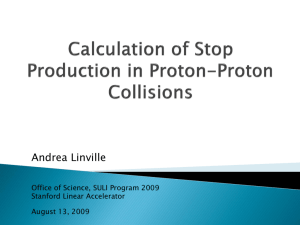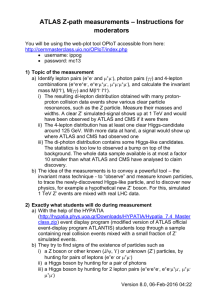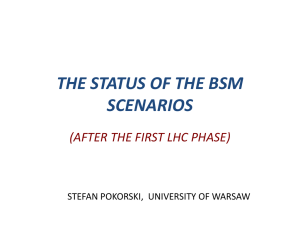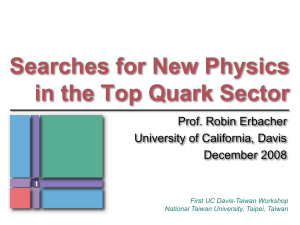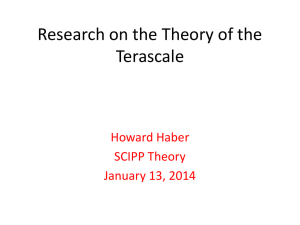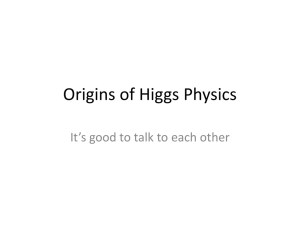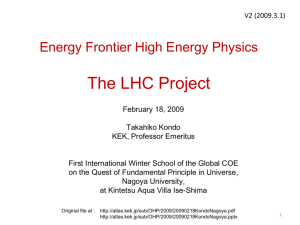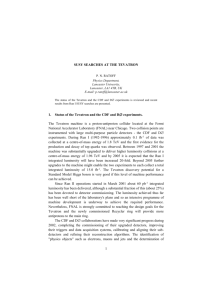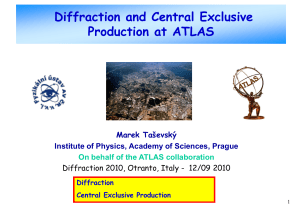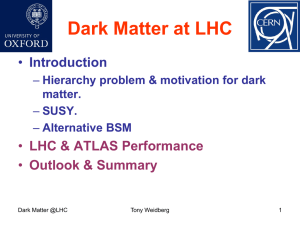ATLAS SUSY Results - University of Oxford Department of Physics
advertisement
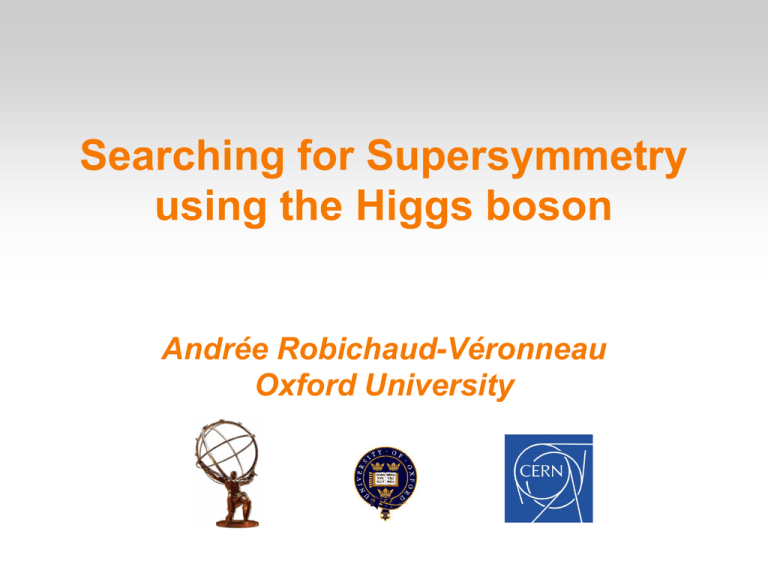
Searching for Supersymmetry using the Higgs boson Andrée Robichaud-Véronneau Oxford University Outline Higgs discovery and its consequences Why Supersymmetry? ATLAS@LHC Search for SUSY decaying to Higgs Summary and Outlook The Standard Model of elementary particles The best description of matter and forces to date Validated by precision measurements over a large range of energy scales Matter made from quarks and leptons 4 elementary forces with their carriers: - Electromagnetic (g) - Weak Nuclear (W, Z) - Strong Nuclear (g) - Gravity (?) "We found a new boson” July 4th, 2012: Announcement of the discovery of a new boson consistent with the Higgs boson Mass measured using ZZ->4l and gg signatures: 126.0 ± 0.4 (stat.) ± 0.4 (syst.) GeV Combination of all channels: ZZ, WW, gg, tt, bb, using 7 and 8 TeV dataset from ATLAS Boson properties compatible with the Standard Model Higgs Phys. Lett. B 716 (2012) 1-29 Nobel prize winners! 2013 Nobel prize in Physics awarded to Prof. Higgs and Englert "for the theoretical discovery of a mechanism that contributes to our understanding of the origin of mass of subatomic particles, and which recently was confirmed through the discovery of the predicted fundamental particle, by the ATLAS and CMS experiments at CERN's Large Hadron Collider” Is that the whole story?* Not quite. We still have a few unanswered questions: Matter/Antimatter imbalance What is Dark Matter? Hierarchy problem ... *Respecting Hincliffe's rule "To infinity... and beyond!” © SUPERSymmetry Introducing a new symmetry of spacetime and fields Heavier superpartners with spin-½ compared to the SM MSSM: 105 parameters to be determined! Introducing R-parity (aka matter parity) SM particles (+1), SUSY particles (-1) Phenomenology centered around the Lightest Supersymmetric Particle (LSP) If conserved, protects against proton decay How can SUSY help? In many ways: Provides a dark matter candidate (LSP) Cancel Higgs mass corrections using sparticle loop Unifies all forces Now, how do we go about to look for it? Large Hadron Collider Using the largest, coolest machine in the world! Proton-proton collider at 8 TeV (soon 14) High luminosity (~1034 cm-2s-1) 4 interaction points – 7 experiments ATLAS Hermetic multipurpose particle detector Inner tracking Calorimetry Muon detection High precision and granularity (~100 million channels) Allow to measure passage of charged particles, leptons, photons, muons and jets LHC performance N= σ L Good data-taking efficiency for the whole dataset and excellent work from the LHC team! Multiple interactions for each proton bunch crossing → pile-up ATLAS reconstruction ATLAS performance Excellent muon reconstruction efficiency over large range of momentum and pseudorapidity Electron reconstruction efficiency greatly improved from 2011 (red) to 2012 (blue) ATLAS performance Jets can be tagged for heavy flavour, such as b or c quarks Correction factor (data/MC) to btagging efficiency Excellent agreement of data and simulation over large energy ranges SUSY search strategy in ATLAS Top and bottom (charm) squarks Electroweak production Cross section Strong production Various scenarios of symmetry breaking, violation of Rparity or exotic long-lived particles considered We look in every corner! Higgs-aware SUSY Knowledge of the mass of the SM Higgs provides constraints in the SUSY models It also gives information on the couplings of the SM Higgs to sparticles All 3 main production types can be probed using Higgs in their signatures We'll focus here on the electroweak production The SUSY Higgses MSSM: Contains 5 Higgses, one of which is the SM Higgs (h0) SUSY Electroweak production R-parity conserving models → Production of sparticle in pair Electroweak production means sleptons, charginos and neutralinos, the SUSY partners of the weak bosons of the SM Order by index in mass → decreasing cross section with increasing mass Chargino-neutralino production ATLAS-CONF-2013-093 Chargino-neutralino production Considering the case of lowest mass states allowing the production of a Higgs boson (Dm[χ02- χ01] > 130 GeV) Favoured in certains area of the MSSM parameter space Choosing h0 → bb, since it has the highest branching ratio. The lepton in the W decay helps to reduce QCD background The LSPs generate large amount of missing energy ATLAS-CONF-2013-093 Signal simplified model Simplified models used to generate signal points m ∞ Settings BR to 100% (for non-SM processes) Adjusting parameters to obtain one single process (3 params for electroweak production: M1, M2, m M2 M1 60 GeV 0 GeV ATLAS-CONF-2013-093 Signal grid Simplified models used to generate signal points Each red dot represent a model Using degenerate masses between χ±1 and χ02. Scanning χ02 mass. ATLAS-CONF-2013-093 SM Backgrounds Many SM process have similar signatures that the one we are looking for in our signal tt: WbWb with one W decaying to ln tt+V: Smaller cross section Single top: Mainly Wt mode W/Z+jets: Contribution from jets mistag Diboson: W(ln)W(qq) mostly W/Z+H: SM process, not missing energy Modelled using Monte Carlo simulation ATLAS-CONF-2013-093 Event selection Using ATLAS recommendations for physics objects reconstruction Define baseline objects Jets with pT > 20 GeV Leptons (e or m) with pT > 10 GeV Apply cleaning cut for detector defects Reject overlapping objects (e, m, jets) in the same detector area Extra overlap removal between e and m DRe-m < 0.1, DRm-m < 0.05 Events are triggered by single lepton requirements Electrons: EF_e24vhi_ medium1 || EF_e60_medium1 Muons: EF_mu24i_tight || EF_mu36_tight ATLAS-CONF-2013-093 Event selection From the baseline object, signal objects are selected Leptons are isolated, with pT > 25 GeV Central jets with pT > 25 GeV, |h| < 2.4 Forward jets with pT > 30 GeV, 2.4 < |h| < 4.5 Preselection 2 highest pT central jets 1 baseline && 1 signal lepton Missing transverse energy (ETmiss) > 100 GeV Nsignal_jets < 4 ATLAS-CONF-2013-093 Event selection Targetted signal cuts 0, 1 or 2 jets to be tagged as coming from a b quark (among the 2 highest pT jets) mjj > 50 GeV (for the 2 highest pT jets) Contransverse mass (mCT) > 160 GeV Transverse mass (mT) at varying thresholds for background estimation and signal measurement ATLAS-CONF-2013-093 Signal region optimisation Optimise analysis selection cuts based on the mass splitting regions ATLAS-CONF-2013-093 Signal region optimisation Two signal regions: SRA at low mass splittings, SRB for high mass splittings SRA (SRB): mT >100 (130) GeV (on top of previous mCT) and ETmiss cuts). Optimised for 105 < mbb < 135 GeV SRA ZN= √ 2 erf − 1(1− 2pvalue ) SRB ATLAS-CONF-2013-093 Signal predicted yields SRA has high yields in low mass splitting regions due to cross section and high a x e in the high mass splitting region SRB consistently has high yields and a x e in high mass splitting region ATLAS-CONF-2013-093 Background kinematics Distributions scaled using background fit results ETmiss cut applied, all other three variables untouched Main background contribution from tt before selections cuts ATLAS-CONF-2013-093 Background estimation Strategy: Reducible background: estimate from data Irreducible background: validate MC simulation with data Use control regions (close kinematically to data, but designed to target background processes) to obtain scale factors to fit MC simulation to data Use validation regions to validate fit (obtain good agreement between data and simulation using fit results above) Apply normalisation to signal regions to get background estimate ATLAS-CONF-2013-093 Control and validation regions Cut above applied to the entire plane mbb binning for all regions: 5075, 75-105, 105-135, 135165, > 165 GeV *: signal bin not considered in backgroundonly fit ATLAS-CONF-2013-093 Systematic uncertainties Lepton (electron or muon) energy scale, resolution, identification and trigger Jet energy scale and resolution, JVF ETmiss resolution Btagging calibration Luminosity Pile-up Generator uncertainties ISR/FSR Parton shower Scale uncertainties Background s uncertainty Signal s uncertainty ATLAS-CONF-2013-093 Profile Likelikood Fit Model dependent fit Background only fit Using only control regions without Higgs bin Obtain normalisation factor for two main background, tt and W+jets Used for model independent limits Using all bins of control and signal regions Obtain normalisation factor for two main backgrounds and the signal strength for each signal point on the grid ATLAS-CONF-2013-093 Data/MC comparison ATLAS-CONF-2013-093 Data/MC comparison ATLAS-CONF-2013-093 Data/MC comparison Data and SM expectations in excellent agreement → No SUSY (yet) ATLAS-CONF-2013-093 Signal region yields SRA (Higgs bin) Observed SRB (Higgs bin) 4 2 tt 2.8 ± 2.8 1.0 ± 0.7 W+jets 0.7 ± 0.4 0.3 ± 0.2 Single top t-channel 0.26 +0.27-0.26 0 Single top Wt-mode 1.4 ± 1.3 0.6 ± 0.4 Z+jets 0.01 +0.02-0.01 0.00 +0.01-0.00 Diboson 0.01 +0.05-0.01 0.05 +0.07-0.05 WH 0.18 ± 0.10 0.12 ± 0.07 tt + V 0.01 ± 0.01 0.11 ± 0.06 Total 5.2 ± 3.0 2.0 ± 0.7 (130,0) GeV 6.5 0.2 (225,0) GeV 1.9 4.1 Background estimate Signal prediction ATLAS-CONF-2013-093 Results interpretation No SUSY found. What do we do next? This is precious information! It should be used to “quantify our ignorance” The same way a discovery like the Higgs boson add additional constraints on theories, using this information, we can rule out mass range for specific models → feedback to phenomenologists Perform likelihood fit using signal and control regions (all bins) ATLAS-CONF-2013-093 Model independent limits Limits on new (non-SM) physics processes that would have been observed if existed Estimated using asymptotic formula and pseudoexperiments (”toys”) - results consistents SRA SRB Observed s95vis (Asymptotic) 0.29 fb 0.22 fb Expected S95exp (Asymptotic) 6.7 +3.1-1.9 4.6 +2.5-1.5 Observed s95vis (Pseudo-experiments) 0.31 fb 0.22 fb Expected S95exp (Pseudo-experiments) 6.8 +2.7-1.4 4.4 +1.8-0.8 ATLAS-CONF-2013-093 Exclusion contour Contour interpolated from individual values of CLs of each model Small grey numbers: cross sections excluded fpr each point Compute limits using -1s line ATLAS-CONF-2013-093 Exclusion limits in 1D Where do we stand? Where do we stand? χ±1χ02→ W± (l±n) χ01 h0(bb) χ01 Summary and Outlook The ATLAS experiment, together with the LHC, had a very successful first run! The Higgs boson discovery has opened new pathways to clear out, looking for SUSY Completing the spectrum of available decays In our search for new physics at the TeV scale, no excess has been observed over the SM background so far Looking forward to see what 14 TeV collisions will reveal! Backup Slides pMSSM T. Rizzo BNL 13 Sep. 2012

